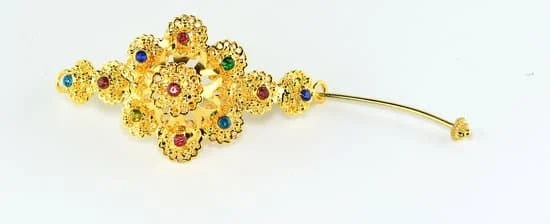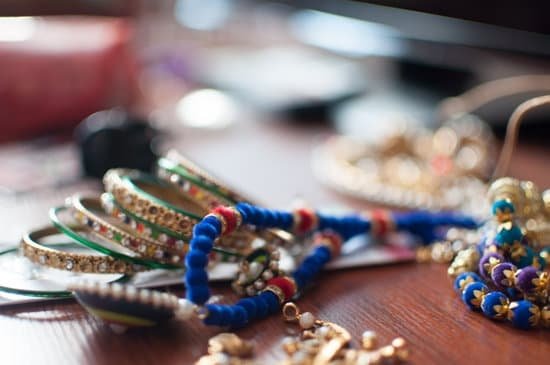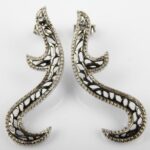Gold filled jewelry has become increasingly popular due to its affordability and attractive appearance. Many people are curious about the lifespan of gold filled jewelry and how long it will retain its beauty. Understanding the basics of gold filled jewelry is essential to answer this question.
Gold filled jewelry, as the name suggests, is made by bonding a layer of solid gold to a base metal core. This process creates a durable piece of jewelry that closely resembles solid gold but at a much lower cost. The thickness of the gold layer in gold filled jewelry typically exceeds that of gold plated or vermeil jewelry, making it more resistant to wear and tear.
One of the key benefits of gold filled jewelry is its affordability compared to solid gold. While solid gold can be prohibitively expensive for many, gold filled options offer a more accessible alternative without compromising on quality or aesthetics. However, it’s important to understand that the lifespan of gold filled jewelry may not be as long as that of solid gold pieces. Factors such as environmental exposure and improper care can affect its durability.
In this article, we will delve into what exactly “gold filled” means and how this type of jewelry is made. We will discuss the factors that can impact the lifespan of gold filled pieces, including environmental factors and maintenance practices. Additionally, we will provide tips on caring for your gold filled jewelry to help extend its longevity. So read on to discover how long your beloved gold filled pieces can last with proper care and attention.
What Does Gold Filled Mean?
Gold filled jewelry is a popular and affordable alternative to solid gold, but what exactly does “gold filled” mean? Understanding the term is essential for anyone considering purchasing or caring for gold filled jewelry.
When a piece of jewelry is described as “gold filled,” it means that it has a layer of solid gold bonded to a base metal core. The process involves heat and pressure, ensuring that the gold layer is permanently bonded to the base metal. The amount of gold in the layer can vary, but it must legally contain at least 5% by weight of gold in order to be considered “gold filled”.
The composition of gold filled jewelry typically consists of multiple layers. The base metal usually consists of materials such as brass or copper, which provide strength and stability. On top of this, there is a layer of bonding metal that facilitates the adhesion between the gold layer and the base metal. Finally, there is the outermost layer made up of solid gold.
One key benefit of gold filled jewelry is its durability compared to other types of plated or coated jewelry. As long as proper care and maintenance are practiced, gold filled jewelry can last for many years without tarnishing or losing its shine. It also offers a more affordable option for those who desire the look and feel of solid gold without the hefty price tag.
| Term | Definition |
|---|---|
| Gold Filled | Jewelry with a layer of solid gold bonded to a base metal core. |
| Composition | Multiple layers including a base metal, bonding metal, and outermost layer of solid gold. |
| Gold Content | Must contain at least 5% by weight of gold to be considered “gold filled.” |
Factors That Affect the Lifespan of Gold Filled Jewelry
Gold filled jewelry offers a more affordable alternative to solid gold, but like any jewelry, it does have its limitations. Understanding the factors that can impact the lifespan of your gold filled pieces will help you make informed decisions when it comes to wearing and caring for them.
One of the primary factors that affect the lifespan of gold filled jewelry is exposure to environmental elements. Water, sweat, and chemicals can all take a toll on the quality of your jewelry over time.
For example, prolonged exposure to water can cause the protective coating on gold filled jewelry to wear off, leading to tarnishing or even rusting of the underlying base metal. Similarly, contact with perspiration or substances such as perfume, lotions, or cleaning agents can corrode or damage the outer layer.
To prolong the lifespan of your gold filled jewelry, proper storage and maintenance are key. It is recommended to store your pieces in individual soft cloth pouches or compartments to prevent scratching and tangling.
Avoid storing them in humid environments or exposing them to direct sunlight as these conditions can accelerate tarnishing. When not being worn, keep your gold filled jewelry away from moisture-prone areas like bathrooms and avoid wearing it while swimming or engaging in activities that may cause excessive sweating.
Regular cleaning also plays a crucial role in maintaining the longevity of gold filled jewelry. To clean your pieces properly, use mild soap and warm water along with a soft-bristled brush. Gently scrub each piece to remove dirt and grime without causing any damage. Rinse thoroughly and pat dry with a soft cloth before storing them away.
By taking these precautions and staying mindful of how you wear and care for your gold filled jewelry, you can extend its lifespan significantly. Investing some time into regular maintenance will ensure that your cherished pieces continue to shine bright for years to come.
- Avoid exposing gold filled jewelry to water, sweat, and chemicals to prevent damage
- Store your pieces properly in soft cloth pouches or compartments
- Refrain from wearing gold filled jewelry while swimming or engaging in activities that cause excessive sweating
- Clean your jewelry regularly with mild soap, warm water, and a soft-bristled brush
- Rinse thoroughly and dry with a soft cloth before storing away
Durability and Tarnish Resistance of Gold Filled Jewelry
Gold filled jewelry is known for its exceptional durability and tarnish resistance, making it a popular choice for those who want the look of solid gold without the high price tag. The construction and composition of gold filled jewelry contribute to its long-lasting nature.
Durability is one of the key advantages of gold filled jewelry. The core of gold filled jewelry is usually made of brass or another base metal, which provides strength and stability. A thick layer of gold alloy is then mechanically bonded to the surface, creating a durable outer layer that can withstand everyday wear and tear. This bonding process ensures that the gold layer does not easily chip or peel off.
In addition to its durability, gold filled jewelry also boasts excellent tarnish resistance. Tarnishing occurs when metals react with elements in the environment, such as air and moisture, resulting in discoloration or darkening of the surface. Gold filled jewelry’s composition helps prevent tarnishing by providing a barrier between the metal base and external factors. The thick layer of gold alloy acts as a protective coating, shielding the inner metal from exposure to oxygen and moisture.
| Property | Gold Plated | Solid Gold | Gold Filled |
|---|---|---|---|
| Durability | Fair (thin layer) | Excellent | Excellent |
| Tarnish Resistance | Poor (thin layer) | Excellent | Excellent |
As shown in the table, gold filled jewelry compares favorably to both gold plated and solid gold jewelry in terms of durability and tarnish resistance. While gold plated jewelry has a thin layer of gold that can wear off over time, and solid gold is susceptible to scratches and dents, gold filled jewelry maintains its quality and appearance for a longer period.
Overall, the durability and tarnish resistance of gold filled jewelry make it a worthy investment. With proper care and maintenance, this type of jewelry can last for many years, allowing you to enjoy its beauty without worrying about frequent replacements or repairs.
How Long Does Gold Filled Jewelry Last?
Estimate of the Average Lifespan for Gold Filled Jewelry
Gold filled jewelry, with proper care and maintenance, can last anywhere from 5 to 30 years depending on various factors. The lifespan of gold filled jewelry is influenced by the thickness of the gold layer, the quality of craftsmanship, and how well it is cared for. On average, gold filled jewelry can maintain its beauty and shine for about 10 to 20 years before showing signs of wear.
Factors Affecting the Durability and Longevity
There are several factors that can affect the durability and longevity of gold filled jewelry. One major factor is exposure to environmental elements such as water, sweat, and chemicals. Moisture and corrosive substances can gradually cause damage to the gold layer over time. It is important to remove gold filled jewelry before swimming, showering, or engaging in activities that may expose it to harsh substances.
Proper storage and maintenance also play a crucial role in extending the lifespan of gold filled jewelry. Storing it in a clean and dry place when not being worn will help prevent scratches and minimize exposure to moisture or harsh elements. Additionally, regularly cleaning your gold filled jewelry using gentle methods will help remove dirt and oils that can tarnish its appearance.
Tips for Extending the Lifespan
To maximize the lifespan of your gold filled jewelry, here are some tips:
- Avoid exposing your jewelry to harsh chemicals such as household cleaners or perfumes.
- Take off your jewelry before engaging in physical activities or applying lotions or cosmetics.
- Clean your gold filled jewelry regularly using mild soapy water and a soft cloth.
- Avoid using abrasive materials or rough brushes when cleaning.
- Store your gold filled jewelry separately from other pieces to prevent scratching.
- Avoid exposing your jewelry to extreme temperatures or direct sunlight for prolonged periods.
By following these guidelines and taking proper care of your gold filled jewelry, you can ensure that it lasts for many years to come and continues to bring beauty to your wardrobe. Remember that each piece is unique, and its longevity can vary based on wear, care, and individual circumstances.
Taking Care of Gold Filled Jewelry
Gold filled jewelry, like any other type of jewelry, requires proper care to ensure its longevity and shine. Here are some practical tips on how to clean and care for your gold filled pieces.
Firstly, it’s important to avoid exposing your gold filled jewelry to harsh chemicals. Chemicals such as chlorine, bleach, and even some cleaning products can damage the finish and layer of gold on the jewelry. Therefore, it is best to remove your gold filled pieces before swimming, bathing, or using any chemical substances.
To clean gold filled jewelry, a gentle approach is recommended. Use mild dish soap and warm water to create a soapy solution. Submerge the jewelry in the solution for a few minutes and then gently scrub with a soft-bristled toothbrush or cloth. Rinse with clean water and pat dry with a soft cloth. Avoid using abrasive materials or brushes that can scratch or damage the surface.
Proper storage is also crucial in maintaining the condition of your gold filled jewelry. When not being worn, store it in a cool and dry place away from direct sunlight. Ideally, place each piece in separate pouches or compartments to prevent scratches or tangling.
It’s important to note that although gold filled jewelry is more durable than other types of plated jewelry, it may still tarnish over time. To restore its shine, you can consider having your gold filled pieces re-plated or re-dipped by professionals. This process involves adding another layer of gold onto the existing one, rejuvenating its appearance and extending its lifespan.
With these simple care practices in mind, you can enjoy your gold filled jewelry for many years to come. Taking proper care will allow you to preserve its beauty and value while making it an enduring part of your personal style.
Signs of Wear and Tear
Gold filled jewelry, while durable and long-lasting, is not immune to wear and tear. Over time, the layer of gold may begin to show signs of deterioration and degradation. It’s important to be aware of these signs so that you can determine when it’s time to replace your gold filled jewelry.
One common sign of wear and tear in gold filled jewelry is the fading or wearing away of the gold layer. As the jewelry is exposed to friction, chemicals, and moisture, the outer layer can gradually wear off, revealing the underlying base metal. This can significantly affect the appearance and value of the jewelry.
Another sign to look out for is tarnishing. Although gold filled jewelry is more tarnish-resistant than other types of metals, it can still tarnish over time. Tarnishing occurs when the outer layer oxidizes and develops a dull or discolored appearance. While some tarnish can be easily removed with proper cleaning methods, extensive tarnish that cannot be restored may indicate that it’s time to replace your jewelry.
Additionally, watch out for any signs of structural damage or weakness in your gold filled jewelry. Regularly inspect clasps, chains, and other components for signs of bending, cracking, or thinning. If you notice any such issues, it may be a sign that the piece is nearing its end and should be replaced.
In summary, being aware of signs of wear and tear in your gold filled jewelry is essential for maintaining their appearance and quality over time. Look out for fading or wearing away of the gold layer, tarnishing, and structural damage. By recognizing these signs early on and taking appropriate action, you can ensure that your gold filled jewelry continues to shine for years to come.
Best Practices for Extending the Lifespan of Gold Filled Jewelry
Cleaning and Care
Proper cleaning and care is essential for extending the lifespan of your gold filled jewelry. To keep your pieces looking their best, it’s important to clean them regularly. Start by gently wiping them with a soft, lint-free cloth to remove any dirt or debris. If your jewelry needs a deeper clean, you can use mild soap and warm water. Avoid using abrasive cleaners or harsh chemicals as they can damage the gold-filled layer.
After cleaning, make sure to thoroughly dry your jewelry before storing it. Moisture can contribute to tarnishing and degradation over time. Additionally, avoid wearing your gold filled jewelry when engaging in activities that may expose it to excessive sweat or chemicals, such as swimming or using household cleaning products.
Proper Storage
Storage plays a significant role in prolonging the lifespan of gold filled jewelry. When not being worn, it’s crucial to store your pieces properly to prevent scratches and minimize exposure to air and moisture. Consider using individual pouches or separate compartments in a jewelry box to keep each piece protected.
You can also prevent tangling and scratching by storing necklaces and bracelets flat or hanging them individually. Avoid storing multiple pieces together without proper separation, as this can lead to damage caused by friction between the items.
Avoid Excessive Wear
While gold filled jewelry is durable, excessive wear can still impact its lifespan. To extend its longevity, consider removing your pieces before participating in activities that may put stress on them or increase the risk of damage. This includes strenuous physical activities like exercising at the gym or playing sports.
Additionally, be mindful of wearing gold filled rings when performing tasks that require repetitive hand movements or when handling rough materials that could potentially scratch or dent the metal.
By following these best practices for cleaning, care, proper storage, and avoiding excessive wear and tear, you can help ensure that your gold filled jewelry maintains its beauty and lasts for many years to come.
Conclusion
In conclusion, gold filled jewelry is an excellent choice for those who want the look and feel of solid gold without the hefty price tag. Understanding the basics of gold filled jewelry, including its definition and manufacturing process, can help consumers make informed decisions when purchasing this type of jewelry.
While gold filled jewelry is durable and tarnish resistant due to its construction and composition, its lifespan can still be affected by various factors. Proper care and maintenance are crucial in prolonging its longevity. It is important to avoid exposing gold filled jewelry to excessive moisture, chemicals, and sweat, as well as to store it properly when not in use. Regular cleaning and inspections are also recommended to identify signs of wear and tear.
When it comes to extending the lifespan of gold filled jewelry, there are several best practices that can be followed. These include avoiding contact with harsh substances or abrasive materials, removing jewelry before engaging in activities that could cause damage or loss, and considering periodic re-plating or re-dipping to restore its original luster.
Frequently Asked Questions
How many years does gold-filled jewelry last?
Gold-filled jewelry is designed to last for a significant period of time, typically ranging from 5 to 30 years. The durability of gold-filled jewelry depends on various factors such as the thickness of the gold layer and how well it’s maintained.
Generally, gold-filled jewelry tends to have a longer lifespan compared to other types of gold-plated or costume jewelry due to its higher gold content. However, it’s important to note that regular wear and tear, exposure to chemicals or harsh conditions can affect the longevity of any piece of jewelry.
Can I shower with gold-filled jewelry?
Yes, you can shower with gold-filled jewelry without major concerns. Gold-filled jewelry is usually more resistant to tarnishing and discoloration compared to pure gold or gold-plated options. It can withstand some exposure to water, so showering with your gold-filled jewelry should not cause any immediate damage.
However, prolonged exposure to moisture and harsh chemicals found in soaps or shampoos may eventually impact the overall appearance and quality of the piece over time. To maintain its longevity, it’s advisable to remove your gold-filled jewelry before swimming in chlorinated pools or using excessive amounts of cleaning products.
Is gold-filled jewelry good for everyday wear?
Gold-filled jewelry is often considered suitable for everyday wear due to its durability and affordability compared to solid gold pieces. Its construction involves a thick layer of karat gold bonded onto a base metal core, creating a sturdy and long-lasting piece that can withstand regular use.
However, it’s important to be mindful of specific activities that may put additional stress on the jewelry such as heavy physical work or intense physical activities where there is risk for accidental damage or impact. With proper care and maintenance, including regular cleaning and storing in a safe place when not worn, gold-filled jewelry can be an excellent option for adding some sparkle and elegance to your everyday outfits.

Welcome to my jewelry blog! My name is Sarah and I am the owner of this blog.
I love making jewelry and sharing my creations with others.
So whether you’re someone who loves wearing jewelry yourself or simply enjoys learning about it, be sure to check out my blog for insightful posts on everything related to this exciting topic!





